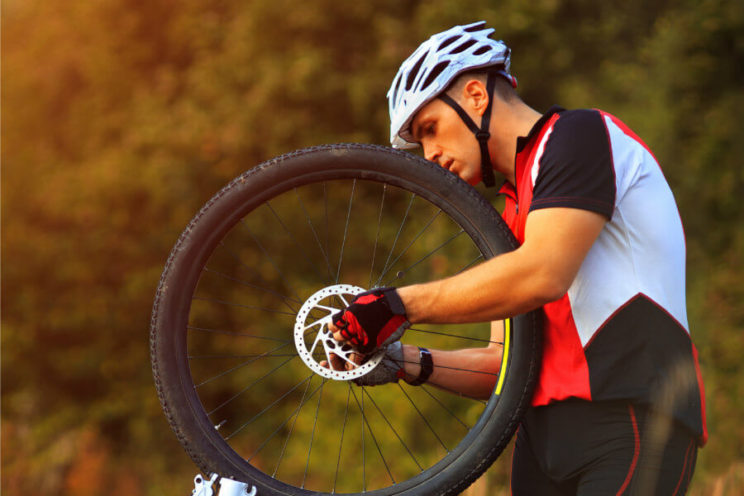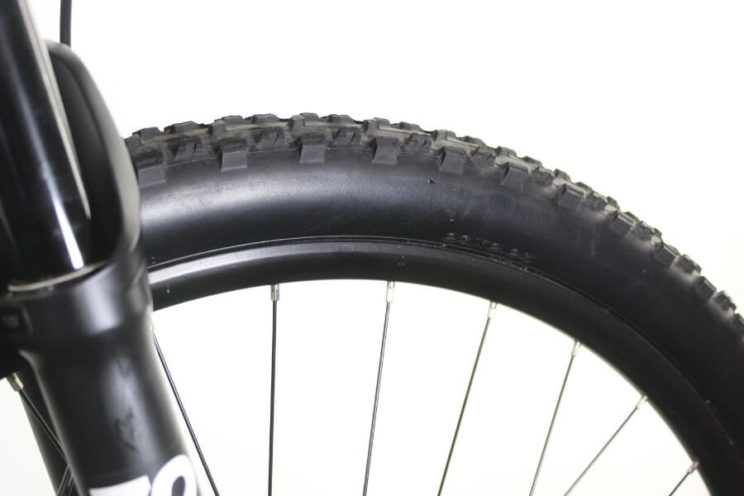The good condition of the bicycle depends on the stability and management of the bicycle, which directly affects the safety of the cyclist. Some covered or worn tires seriously increase the risk of falling and, therefore, injury. In addition to the damage caused to the bicycle.
That is why it is crucial to know when the time has come to change them for new ones. The duration of one or another cover varies depending on its material, modality and use. But there are general guidelines and common symptoms that will indicate the time to discard some old tires and replace them with new ones.
Factors that influence the wear of the covers
The wear of the covers and tires of a bicycle depends on two types of factors:
External: land, modality and driving style
Here the type of terrain, the weather conditions, the practiced modality and the cyclist's driving style enters. Usually the covers wear faster and faster than dry and irregular than in wet and firm. However, moisture can also negatively affect gums and compounds of the rolling band.
In addition, the practiced modality must be taken into account (
road,
mountain,
Grave, etc) and the management of the bike, to extend or shorten the life of the roof. An MTB tire will usually have a shorter life than one of the road. On the other hand, a more aggressive and technical cyclist will need covers with more resistant and durable rubber than the one dedicated to rolling peacefully by the plain.
Internal: Material and Cover Construction
They concern the tire construction itself, its materials and also its measures. Every cover is built with two layers. The first is the rolling band, made of rubber or rubber with reliefs or tacos to increase grip and traction. The second layer is the housing, the inner layer made with a braided nylon that determines the lightness and protection against punctures.
A thinner rolling band with smaller tacos or reliefs will have a more rolling character and will enhance the speed. But the friction wear with the terrain will be faster. The housing, on the other hand, does not determine the wear of the tire but the weight of it and its protection against punctures.
When to change the cycling covers

To know if a cover is worn or not to examine the rolling band, that is, its outer surface. But the verification will be different depending on the type of tire used for each cycling modality. Next we indicate what are the symptoms that will help us to know that the cover is worn and the time has come to change it, depending on whether it is a mountain or road bike tire.
Mountain Bike Tires
The first worn cover symptom will be found in the central part of the rolling band. If the tacos have lost a good part of their height or directly have disappeared you will have to change the roof.
Do not expect that lateral tacos are also worn, usually larger and durable. The main wear symptom is in the central band. If the stability of the bicycle is very smooth, it will be compromised, as well as the resistance to the punctures.
Wear on road tires
The review of wear on a road cover is different, due to the absence of tacos. It will be necessary to fix the profile or silhouette. A coverless cover has a curved profile between flank and flank. When this curve becomes flat, it is worn and will have to be replaced.
In addition, there are other signs that indicate the wear of a road tire. Some of them have small grooves or drawings to increase adherence in wet, cobblestone, etc. If this drawing disappears or the cover is blurred, it will be asking for a substitution. Likewise, the appearance of cracks or cuts in the rolling band announce the end of their useful life.
How to replace the covers of my bicycle

The replacement operation is very simple, although a certain ability to separate the rings from the side rails of the tire is necessary. It will be enough to completely deflate the wheel and, with the hands, push the tire flank towards the center of the tire to open a hole on the side, from where we will separate both.
For the withdrawal of the hoop you can help you detachable. Although if you use camera you must introduce them carefully so as not to pinch it and suffer from a puncture.
Sometimes this operation can be complicated more than you think, especially if you have tubelled the tires, because the sealant fluid may have hit the tire with the tire or the flanks themselves making disassembly very difficult. If that happens to you, try to introduce a little air with the pump to take off and deflate again. In these cases you must have a little patience and separate the flank little by little.
Main risks of rolling with worn covers
The first direct consequence of rolling with worn covers or hurrying more than it is due is the loss of grip and stability of the bicycle. It shows above all when taking curves and climbing with slopes with dirty or loose firm. This can cause unforeseen reactions, that the bicycle suddenly gets out of control and lose balance. And the inevitable end is to have a fall.
On the other hand, a symptom of wear and clear consequence of not having changed the covers when you should be the unusual increase in punctures. The rolling band is less thick and smoother and any sharp object, however small, can pierce and also the housing, with great ease.
In general, bicycle behavior is affected. The suspension work is not perceived the same, the management is more clumsy and requires greater muscle effort. All these setbacks are added to decrease the performance and that, ultimately, do not enjoy bicycle output.
Recommendations for your bike covers to last more

Finally, we want to share very simple tips or tricks that you can apply in your day to day to increase the duration of your covers:
Inflate the wheels at the right pressure
Excessive or insufficient pressure is one of the main causes that the wear of the covers is accelerated. That is why it is important
Know the appropriate pressure to carry the tires on your bicycle. To approach as much as possible we can consult the recommended pressures of the manufacturer and from there increasing or decreasing the pressure depending on the type of route, the wheel position (front or rear), the status of the land or Your driving style, among other factors.
Check the pressure frequently
You must also check before each output that the pressure has not decreased. The main manufacturers recommend doing at least, once a month. But we recommend doing it every time you are going to ride by bike. Always roll with the correct pressure has a lower wear.
Keep the rest of the bike in good condition
Suspensions, brakes, change ...
Have all bike components in good condition It also impacts the lower wear of the tires. Some
unjustified brakes Or without touch, for example, they will cause the pneumatic to skid or not stop when you have to do it.
Do not do unnecessary skids
The skid increases exponentially the wear of the rolling band. That is why he avoids doing it unnecessarily. Take the curves at moderate speed, also using your body to stay in the path and avoid touching the brake minimum.
Avoid sudden changes of speed
A very aggressive driving with strong accelerations and braking is undermining the tire resistance. On the road, for example, to the
face the descent of a port It is more efficient and safe to take the curves in a controlled way, modulating the braking, than to lower at full speed only for obtaining profits that in many cases will be marginal.
Avoid irregular firm and dirty arcenes
Continuing with examples of road cycling, shoot on roads with good asphalt will end up extending the useful life of the roofs. For this, it avoids, as far as possible the passage through bumpy roads or with very dirty arcenes. All these details add up to rubber degradation and loss of adhesion.
 To know if a cover is worn or not to examine the rolling band, that is, its outer surface. But the verification will be different depending on the type of tire used for each cycling modality. Next we indicate what are the symptoms that will help us to know that the cover is worn and the time has come to change it, depending on whether it is a mountain or road bike tire.
To know if a cover is worn or not to examine the rolling band, that is, its outer surface. But the verification will be different depending on the type of tire used for each cycling modality. Next we indicate what are the symptoms that will help us to know that the cover is worn and the time has come to change it, depending on whether it is a mountain or road bike tire.
 The replacement operation is very simple, although a certain ability to separate the rings from the side rails of the tire is necessary. It will be enough to completely deflate the wheel and, with the hands, push the tire flank towards the center of the tire to open a hole on the side, from where we will separate both.
For the withdrawal of the hoop you can help you detachable. Although if you use camera you must introduce them carefully so as not to pinch it and suffer from a puncture.
Sometimes this operation can be complicated more than you think, especially if you have tubelled the tires, because the sealant fluid may have hit the tire with the tire or the flanks themselves making disassembly very difficult. If that happens to you, try to introduce a little air with the pump to take off and deflate again. In these cases you must have a little patience and separate the flank little by little.
The replacement operation is very simple, although a certain ability to separate the rings from the side rails of the tire is necessary. It will be enough to completely deflate the wheel and, with the hands, push the tire flank towards the center of the tire to open a hole on the side, from where we will separate both.
For the withdrawal of the hoop you can help you detachable. Although if you use camera you must introduce them carefully so as not to pinch it and suffer from a puncture.
Sometimes this operation can be complicated more than you think, especially if you have tubelled the tires, because the sealant fluid may have hit the tire with the tire or the flanks themselves making disassembly very difficult. If that happens to you, try to introduce a little air with the pump to take off and deflate again. In these cases you must have a little patience and separate the flank little by little.
 Finally, we want to share very simple tips or tricks that you can apply in your day to day to increase the duration of your covers:
Finally, we want to share very simple tips or tricks that you can apply in your day to day to increase the duration of your covers:












